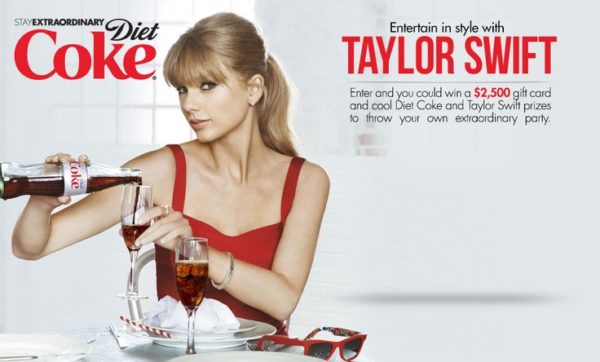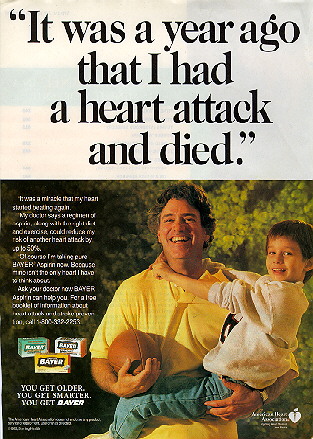This persuasion technique tries to link a product, service, or idea with something
already liked or desired by the target audience, such as fun, pleasure, beauty, security, intimacy,
success, wealth, etc. The media message doesn’t make explicit claims that you’ll get these things;
the association is implied. Association can be a very powerful technique. A good ad can create a
strong emotional response and then associate that feeling with a brand (family = Coke, victory =
Nike). This process is known as emotional transfer. Several of the persuasion techniques below, like
Beautiful people, Warm & fuzzy, Symbols and Nostalgia, are specific types of association.
https://www.google.co.id/search?safe=strict&biw=1366&bih=657&tbm=isch&sa=1&ei=Bz3hW4bhEZCoyAOp9qyIBQ&q=association++advertising&oq=association++advertising&gs_l=img.3..0l3j0i8i30l7.24040.28487..29764...0.0..0.220.858.0j5j1......1....1..gws-wiz-img.a75lAkOgEG0#imgrc=4RdZpka6naBiqM:
2. Beautiful people
Beautiful people uses good-looking models (who may also be celebrities) to
attract our attention. This technique is extremely common in ads, which may also imply (but never
promise!) that we’ll look like the models if we use the product.

http://lazyspleen.blogspot.com/2012/11/randomville-real-people-behind-some.html
3. Celebrities
(A type of Testimonial – the opposite of Plain folks.) We tend to pay attention to
famous people. That’s why they’re famous! Ads often use celebrities to grab our attention. By
appearing in an ad, celebrities implicitly endorse a product; sometimes the endorsement is explicit.
Many people know that companies pay celebrities a lot of money to appear in their ads (Nike’s huge
contracts with leading athletes, for example, are well known) but this type of testimonial still seems to be effective.

https://www.google.co.id/search?safe=strict&biw=1366&bih=657&tbm=isch&sa=1&ei=8UHhW_zrJYvfvATkkpLoAw&q=celebrities+advertising&oq=celebrities+advertising&gs_l=img.3...0.0..33559...0.0..0.0.0.......1......gws-wiz-img.QjBRqAKgt0Q#imgrc=ZTvex4TUicq34M:
4. Bandwagon
Many ads show lots of people using the product, implying that "everyone is doing
it" (or at least, "all the cool people are doing it"). No one likes to be left out or left behind, and these
ads urge us to "jump on the bandwagon.” Politicians use the same technique when they say, "The
American people want..." How do they know?

https://www.google.co.id/search?safe=strict&biw=1366&bih=657&tbm=isch&sa=1&ei=IULhW_39NMHzvASWm6PIBw&q=bandwagon+advertising&oq=bandwagon+advertising&gs_l=img.3..0l5j0i7i30l5.235182.240377..241331...2.0..1.1191.6436.0j4j3j4j2j0j2j1......1....1..gws-wiz-img.......0i8i7i30j0i67.PuNWh6Jh8vk#imgrc=s3yh_9tWdfO9JM:
5. Fear
This is the opposite of the Association technique. It uses something disliked or feared by
the intended audience (like bad breath, failure, high taxes or terrorism) to promote a "solution.” Ads
use fear to sell us products that claim to prevent or fix the problem. Politicians and advocacy groups
stoke our fears to get elected or to gain support.

https://www.google.co.id/search?safe=strict&biw=1366&bih=657&tbm=isch&sa=1&ei=FkPhW6ulGJKm9QPm-5bgDw&q=fear+advertising&oq=fea&gs_l=img.3.0.0i67l4j0j0i67j0l4.111581.121484..123286...2.0..5.1367.3611.2j11j3j7-1......3....1..gws-wiz-img.....0..0i30j0i8i30j35i39j0i10.Y1SJ0nAr3_A#imgrc=emcyEYcSAkDMJM:
6. Humor
Many ads use humor because it grabs our attention and it’s a powerful persuasion
technique. When we laugh, we feel good. Advertisers make us laugh and then show us their product
or logo because they’re trying to connect that good feeling to their product. They hope that when we
see their product in a store, we’ll subtly re-experience that good feeling and select their product.
Advocacy messages (and news) rarely use humor because it can undermine their credibility; an
exception is political satire.
.jpg)
https://www.google.co.id/search?safe=strict&biw=1366&bih=657&tbm=isch&sa=1&ei=lkPhW_mVGMvyvgS-9JIo&q=humor+advertising&oq=humor+advertising&gs_l=img.3..0l4j0i7i30l2j0i5i30l2j0i24l2.150848.153032..153762...0.0..1.252.1804.0j9j2......1....1..gws-wiz-img.......0i67.dF-Q4cbyWmU#imgrc=n2JPJZ_CkOTeYM:
7. Testimonials
Media messages often show people testifying about the value or quality of a
product, or endorsing an idea. They can be experts, celebrities, or plain folks. We tend to believe
them because they appear to be a neutral third party (a pop star, for example, not the lipstick maker,
or a community member instead of the politician running for office.) This technique works best when
it seems like the person “testifying” is doing so because they genuinely like the product or agree with
the idea. Some testimonials may be less effective when we recognize that the person is getting paid
to endorse the product.

https://www.google.co.id/search?safe=strict&biw=1366&bih=657&tbm=isch&sa=1&ei=MkThW4fRCdr69QPo0KqQBQ&q=testimonial+advertising&oq=testimonial&gs_l=img.3.0.0i67l2j0j0i67j0l6.126101.130416..131854...0.0..4.380.3065.0j9j4j2......2....1..gws-wiz-img.....0..0i30j0i5i30j0i8i30j0i24j35i39.bJfv7VO3r40#imgrc=gstP92RrLkaGEM:
8. Intensity
The language of ads is full of intensifiers, including superlatives (greatest, best, most,
fastest, lowest prices), comparatives (more, better than, improved, increased, fewer calories),
hyperbole (amazing, incredible, forever), exaggeration, and many other ways to hype the product.

https://www.google.co.id/search?safe=strict&biw=1366&bih=657&tbm=isch&sa=1&ei=QEXhW4b_LZem9QO5jam4Aw&q=intensity+advertising&oq=intensity+advertising&gs_l=img.3..0.229906.234748..235692...0.0..1.203.2561.1j15j1......1....1..gws-wiz-img.......0i7i30j0i67.Ep4-Nj59xXI#imgdii=EdTwlb5KYZ8_lM:&imgrc=3LFawI2ByBHC4M:
9. Bribery.
This technique tries to persuade us to buy a product by promising to give us something
else, like a discount, a rebate, a coupon, or a "free gift.” Sales, special offers, contests, and
sweepstakes are all forms of bribery. Unfortunately, we don’t really get something for free -- part of
the sales price covers the cost of the bribe.

https://www.google.co.id/search?safe=strict&biw=1366&bih=657&tbm=isch&sa=1&ei=LkbhW5LjB4iFvQT_5a3wBA&q=bribery+advertising&oq=bribery+advertising&gs_l=img.3..0l3.164049.166895..168055...0.0..0.196.1838.0j12......1....1..gws-wiz-img.......0i7i30j0i67.FMwc85HoQCA#imgrc=0UCpGULX3TbmuM:
10. Experts.
(A type of Testimonial.) We rely on experts to advise us about things that we don’t
know ourselves. Scientists, doctors, professors and other professionals often appear in ads and
advocacy messages, lending their credibility to the product, service, or idea being sold. Sometimes,
“plain folks” can also be experts, as when a mother endorses a brand of baby powder or a
construction worker endorses a treatment for sore muscles.

:https://www.google.co.id/search?safe=strict&biw=1366&bih=657&tbm=isch&sa=1&ei=2UbhW5mzJsvMvgTfqIWIDQ&q=expert+advertising&oq=expert+advertising&gs_l=img.3..0j0i7i30j0i8i30j0i24l2.153699.156891..157475...0.0..1.278.2234.0j9j3......1....1..gws-wiz-img.......0i67j0i8i7i30.mkcUqosZ02I#imgrc=bfYMqZxVbf2R9M:
Created by the Media Literacy Project. Shared under a Creative Commons Attribution-NonCommercial-ShareAlike 3.0
License. Details at http://creativecommons.org/licenses/by-nc-sa/3.0/us/


Tidak ada komentar:
Posting Komentar